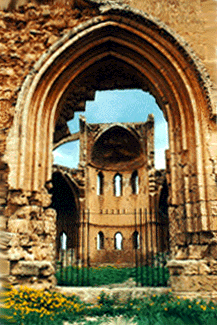|
 This
cathedral was probably built in opposition to the nearby Latin (Roman
Catholic) cathedral of St. Nicholas (now Lala
Mustafa Pasha mosque). An exterior view of the apse at the eastern
end is shown above. This
cathedral was probably built in opposition to the nearby Latin (Roman
Catholic) cathedral of St. Nicholas (now Lala
Mustafa Pasha mosque). An exterior view of the apse at the eastern
end is shown above.
Here we have the
typical semicircular apse while the central part of the cathedral had a
large dome which in this case has been blown off in 1571. Notice how the
bombardment came from one side, and this is the side facing the distant
bastion of Djanboulat,
where the Turkish artillery was deployed in 1570.
 As
you go round the various churches, it will be observed that most of the
damage is on the the side facing Djanboulat. As
you go round the various churches, it will be observed that most of the
damage is on the the side facing Djanboulat.
One must remember,
also, that the city of Famagusta suffered from two severe earthquakes in
mid 18th century.
With the numerous
cannon balls lying about both in among the ruins and in private gardens,
one gets the impression that the siege only took place a few years ago.
This is why Famagusta as a historical centre unique in all Cyprus.
Inside the cathedral
are some fragments of wall painting, then best being in the eastern
apse. In the nave are the foundations of some Roman columns where the
method of binding stones with iron ties is visible. The use of iron ties
for constructing masonry without cement was often used by the Romans in
harbours and jetties.
|

|
|
Inside
the Cathedral's ruins frescoes can still be seen. |
|









